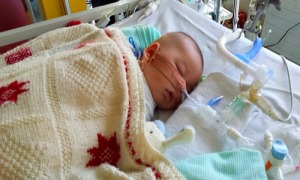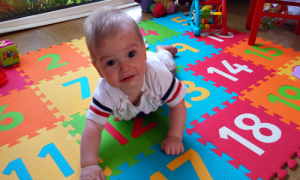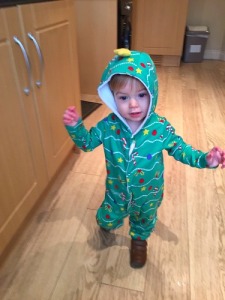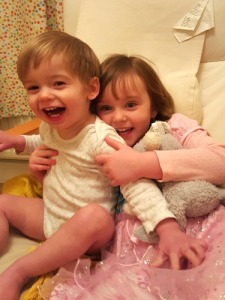Since Alistair had his stroke, Google has been both my best friend and my worst enemy. You know what they say about doctor Google. At one point my husband put a block on the terms “cerebral palsy” and “stroke” to try and curb my chronic Googling, which would leave me in a miserable state for weeks and months at a time, in the early days. All I wanted were answers and reassurance. I wanted to know what the effects would be, what would happen, that he would be ok. But in cases of neurological trauma, even the professionals can give no definite answers. Wait and see – I despise these words and I challenge anyone whose child has suffered a brain injury to “wait and see” with their sanity intact.
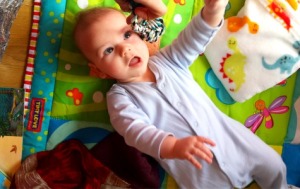
I don’t know what changed – me, probably, as well as Alistair – but Google became my coping mechanism and my best source of information (until we met our wonderful physio when he was 6 months old). Knowledge was power, and I knew that to best help my son, I needed to understand the condition, treatments and become paediatric physiotherapist and occupational therapist in one.
Even before we started seeing NHS therapists officially, I was doing sensory massage, stretches, body awareness exercises, strengthening exercises and encouraging the use of his left affected side – particularly his hand and arm – thanks to self-education on Google.
Constraint Induced Movement Therapy – CIMT
It was through Google that I discovered constraint induced movement therapy, or CIMT.
Now, for those as of yet unfamiliar with hemiplegia, you must remember that children (and adults) struggle to use their affected side – some may not even be aware that it is there due to compromised sensation. The result is that people with hemiplegia do not use that side effectively, or at all, and their hand in particular may remain in a tight closed fist, with the brain injury meaning it lacks the ability to do something as seemingly simple as opening it, never mind grasping with it or using it in any capacity. Children with hemiplegia generally become very dominant on their unaffected side (note please, I never say good or bad side – I hate that). It’s a vicious circle – they don’t use their affected hand, so the neural pathways don’t develop to help them use it. It is only through use that these pathways can begin to form, rerouting around the area of brain injury.
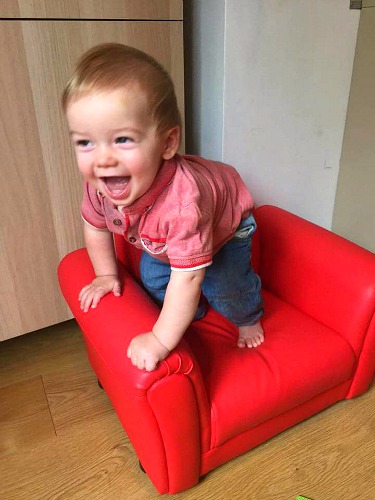
I knew therefore that it was absolutely essential Alistair use his left hand as much as possible. I placed toys on his left side, stroked different textures against his skin, massaged and stimulated his hand as much as I could. When I came across CIMT it vindicated everything I was already doing. The principle of the treatment is to restrict the use of the dominant side by putting the arm and hand in a cast, to prompt continuous use in the affected side. Some people may think it sounds cruel, but I don’t think it’s cruel to strive to give your child the opportunity to meet their fullest potential.
I started off with a modified version of CIMT, gently holding down his right hand, and from the age of about 6 months I used a padded ski mitt to cover it for short periods, focusing on knocking down towers, batting and playing with his left hand to the best of his ability. Thankfully Alistair was still so young that it didn’t seem mean to him at all, just a normal part of play. The results have been wonderful and even now at 18 months he uses his left affected hand spontaneously and frequently, although his right is still very dominant and has significantly better function.
CIMT – the Research
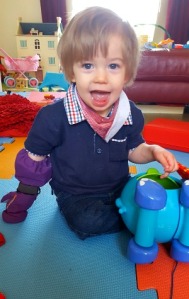
It was the good results that we got from the modified CIMT that led me to pursue the full casting. This method is practiced in America and overseas, but not widely in the UK, and the awareness through much of the NHS as to the benefits doesn’t seem to be there. Good old Google did however find a private company in the UK who offered it as a therapy programme. The difficulty… The clinics were in Manchester and Liverpool, and were three weeks in duration, whereas we live in Kent. I put it to the back of mind, but it wouldn’t stay there. There seemed to be so many reasons why we shouldn’t do it, but they weren’t enough to override the best reason why we should – that I felt Alistair would significantly benefit from the treatment in such a way that it would improve the quality of the rest of his life. I hope I’m right. Let me tell you more…
Watching the CIMT clinic’s video case studies – along with others on YouTube – showed impressive results, but I’m the type that needs hard facts. I needed to see studies. Back to Google I went and I read every study that I could find. For those that are interested in looking for themselves, I found many here on CHASA (Children’s Hemiplegia and Stroke Association). These studies convinced me that CIMT could significantly benefit Alistair, however most of the medical professionals I saw weren’t enthusiastic. As I mentioned, CIMT isn’t widely practiced in the UK. There is awareness of the modified form using a mitt, but a full cast is rarely used and I had a paediatrician, occupational therapist and neurologist play it down as an option, although the latter admitted neuro-rehab wasn’t really her field. My son’s physio however, is American, and significantly had seen it done and vouched for the results. Not only for hand and arm use I might add, but in strengthening the shoulder and trunk, which ultimately would help with walking gait and weight shifting. His physio is an extremely experienced, qualified and knowledgeable paediatric specialist. I respect her enormously – more than anyone else – and her word and the studies I had read were enough for me to consider the other professionals as well-meaning, but less informed.
Some might say it was a bold (stupid?) decision to go against the feelings of so many professionals, but I was confident in the research that I had done. I felt – and feel – that CIMT will give Alistair significantly better function in his left hand in a short space of time. He will use it more often and with more success. His bi-manual use of both hands together (essential to effectively complete every day tasks, such as dressing, etc.) will be improved at an earlier age, allowing him to develop even further and more rapidly in his younger years – the most important time in brain development and when it can most effectively recover from its injury. Alistair already uses his hand so spontaneously and consistently despite its affected function. He tries so hard to use it, doesn’t get frustrated and doesn’t give up. He is a superstar, and if I can help give him the function to match his effort, we are onto a winner.
And the worst case scenario that it doesn’t work – we would be out of pocket, but I could look my son in the eyes when he was older, and tell him that I had done all that was within my power to do for him.
CIMT – the planning and logistics
Decided in principle, I had a phone consultation with the clinic and there were more obstacles to consider. The price was significant (although it is possible to apply elsewhere for funding, as well as fund privately), we would need accommodation for three weeks in Manchester or Liverpool on top of that, and a hotel stay didn’t appeal without home practicalities (such as cooking facilities and a washing machine). I also had work and my three year old daughter to consider (and her needs, although different and somewhat simpler than Alistair’s, are no less important to me).
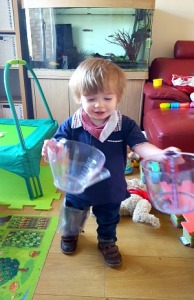
But where there’s a will there’s a way (although I realise I’m more fortunate than many in our circumstances). My generous mother and grandmother offered to pay for the therapy between them. But when to do it? The earliest the clinic offered the therapy was from 18 months of age – that would be end of April/May 2016. Perfect. I was keen to do it as early as possible to give Alistair maximum function from a young age, when the brain is most malleable and able to “rewire”. May would be before Freya started school, and allow us to be home in time for her birthday. Suddenly everything was falling into place.
My husband and I have rented a 3 bedroom house for 3 weeks in Manchester through Air BnB, so we can cook and live as normal during the CIMT treatment. It’s a 25 minutes’ walk from one of the clinics. Returning to work after maternity leave, I carried over an extra two weeks of annual leave to help cover the time off (although I also considered unpaid ‘Parental Leave’); work have been very supportive. My daughter, Freya, will come with me to stay at the house, and my husband – who is self-employed – will stay as much as he can. Other family members are enlisted for help during our stay while he isn’t there. We’ve decided to do our best to make “a holiday” of it around Alistair’s treatment, and have found lots to do in the local area for Freya, while Alistair is with either myself or my husband for the 3 hours daily therapy at the clinic. Aside from the cast – which I think he’ll soon get used to – it’s going to be one, big therapy-play session for him!
It’s really happening!
Alistair had a face-to-face pre-assessment in January and will be reassessed before we start the casting. The 3 months between then and now, which seemed a long time to wait, has flown, and we’re gearing up to head up to Manchester now!
The purpose of this essay… Because I need to get my excitement and nervousness down in words. Because it might help someone looking into the same type of therapy. Because I need to record for myself the experience and results to (hopefully) come. Well done if you got to the end of this ramble! But this is only the beginning.




